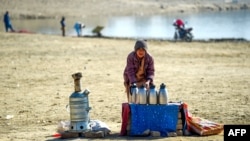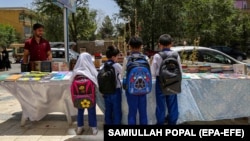
Welcome to The Azadi Briefing, an RFE/RL newsletter that unpacks the key issues in Afghanistan. To subscribe, click here.
I'm Abubakar Siddique, senior correspondent at RFE/RL's Radio Azadi. Here's what I've been tracking and what I'm keeping an eye on in the days ahead.
The Key Issue
The UN Office for the Coordination of Humanitarian Affairs (OCHA) has warned that an unseasonably dry and warm winter could have devastating consequences for Afghanistan.
“Without substantial snowfall soon, the country could experience a severe drought,” the agency said on January 23, adding that a lack of water could wreak havoc on rain-dependent crops and prevent pastures from recovering, prompting the rural population to move in search of water.
Afghan farmers said they are already feeling the devastating impact of drought.
“People are facing hunger and poverty. There is no work, and most have not cultivated their lands,” Farhad Gul, a farmer in the central province of Ghazni, told RFE/RL’s Radio Azadi. “Our cattle are hungry because there is no grass.”
During the past two decades, droughts have sporadically hit the mountainous country, where most of its population of 40 million needs humanitarian aid to survive, according to the UN.
Why It's Important: Drought is a major threat to the livelihoods of rural Afghans, many of whom depend on subsistence agriculture and raising livestock.
Parts of Afghanistan were already reeling from persistent drought before the winter. Decades of war, environmental degradation, and climate change have made the country increasingly vulnerable to drought, according to experts.
Severe droughts could exacerbate the devastating economic and humanitarian crises in Afghanistan, where millions are on the verge of starvation.
The lack of winter rain and snowfall could cause a food shortage, with Afghan farmers unable to cultivate spring crops. Their livestock, too, could be threatened by the lack of water.
This, in turn, could threaten the Afghan economy, which is “stabilizing at a very low level of activity” after shrinking 27 percent since 2020, according to the UN.
“For two successive years, 4 out of 5 households were impacted by drought and/or economic shocks,” the UN report said, adding that “69 percent of Afghans are subsistence insecure -- meaning they do not have adequate resources for basic subsistence living.”
What's Next: Amid the gloomy predictions, the United States Agency for International Development’s Famine Early Warning Systems Network has predicted rain and snowfall across the country in February.
While the rainfall is likely to be lower than during typical winters, it could provide relief to some of the most vulnerable Afghans.
What To Keep An Eye On
The Taliban has continued to wage a violent crackdown on independent media, forcing a growing number of journalists to abandon their professions.
"Before I was released, my family was forced to guarantee that I would no longer work with the international media,” an unnamed journalist recently released from Taliban detention told Radio Azadi.
"They slapped me, threatened me, and tied me up,” said another journalist who was also recently detained by the Taliban. "They told me: 'Don't dig around for the truth. Just take care of your family.'"
Both reporters talked on condition of anonymity due to fears of retribution.
Why It's Important: Since seizing power, the Taliban has imposed severe restrictions on the media and access to information, and increased detentions of reporters, activists, and other critics as part of its brutal crackdown on dissent.
That has forced hundreds of reporters and media workers to flee their homeland or abandon their professions.
That's all from me for now. Don't forget to send me any questions, comments, or tips that you have. You can always reach us at azadi.english@rferl.org.
Until next time,
Abubakar Siddique
If you enjoyed this briefing and don't want to miss the next edition, subscribe here. It will be sent to your inbox every Friday. You can always reach us at azadi.english@rferl.org.






